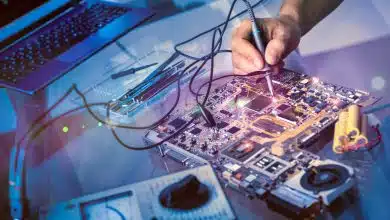Navigating the vast landscape of energy types can be intricate, and one topic that often sparks curiosity is the nature of electric energy. More specifically, is electric energy a form of kinetic or potential energy? As we shed light on these questions, we will uncover broader connections to principles of physics and their application in our daily lives.
Key Takeaways
- Electric energy is a category of its own, falling under the umbrella of electromagnetic energy.
- Electric energy can act as potential energy when stored (for example, in batteries or capacitors) and kinetic energy when in motion (like in an electric current).
- Electric energy is incredibly versatile, with the ability to be converted into various other forms of energy, such as mechanical, thermal, or sound energy.
- The methods of generating electric energy can be classified as renewable or non-renewable, depending on the source.
Is Electric Energy a Form of Kinetic or Potential Energy?
Understanding the nature of electric energy can be perplexing, particularly when it comes to categorizing it as either kinetic or potential energy. To better understand this, we must first dive into the definitions and characteristics of these energy types.
Definitions and Characteristics
Kinetic Energy: It is the energy an object possesses due to its motion. Any moving object has kinetic energy.
Potential Energy: This is the stored energy an object possesses due to its position relative to other objects. This energy has the potential to be converted into kinetic energy.
Electric Energy: It is the energy carried by an electric charge or by a flow of electric current. It is commonly produced by electric generators or batteries.
The key thing to remember here is that kinetic and potential energy are categories of mechanical energy, while electric energy is a category of its own, falling under the broader umbrella of electromagnetic energy.
However, in certain contexts, electric energy can be seen as either potential or kinetic energy. Let’s explore these scenarios in more detail.
Electric Energy as Potential Energy
Electric energy is often stored as potential energy. We can see this in action in several ways:
- Capacitors: These are devices used in electric circuits to store electric energy in an electric field. The energy stored is potential energy.
- Batteries: Batteries store electric energy in the form of chemical potential energy. When a device is connected, a chemical reaction occurs, releasing this stored energy as electric current.
- Electric field: An electric charge in an electric field possesses potential energy due to its position relative to other charges. The energy can be released as kinetic energy when the charge moves.
Electric Energy as Kinetic Energy
On the other hand, electric energy can also manifest as kinetic energy. Here are some examples:
- Electric Current: The flow of electric charge (electric current) is kinetic energy in action. When you plug in an electrical appliance, the movement of electrons from the outlet to the appliance represents kinetic energy.
- Electromagnetic Radiation: Electromagnetic radiation, such as light, is a form of energy that is carried by waves. These waves are essentially fluctuations in electric and magnetic fields, and the energy carried by these waves can be viewed as kinetic energy.
Conversion of Energy
A key principle in physics is the law of conservation of energy. This law states that energy cannot be created or destroyed, but it can be transferred or transformed from one form to another. This principle is visible in the transformation of electric energy into other forms:
- Mechanical Energy: Electric energy is often transformed into mechanical energy in devices like electric motors.
- Thermal Energy: When a device like a toaster or a heater is in use, electric energy is converted into thermal energy.
- Sound Energy: Speakers and headphones convert electric energy into sound energy.
| Energy Source | Conversion |
|---|---|
| Electric Motor | Electric Energy to Mechanical Energy |
| Heater | Electric Energy to Thermal Energy |
| Speaker | Electric Energy to Sound Energy |
FAQs:
1. Can electric energy be converted to other forms of energy?
Absolutely, electric energy is incredibly versatile and can be converted into many other forms of energy. It’s essential to recognize this because it explains how a wide range of appliances and machinery operate.
In a microwave, for instance, electric energy is converted into electromagnetic radiation in the form of microwaves. These microwaves cause water molecules in food to vibrate, producing thermal energy that heats your food.
Electricity is also converted into light energy in lamps or LED screens, into mechanical energy in electric fans, and into sound energy in radios or televisions. This broad convertibility of electric energy makes it a fundamental pillar in technology and modern civilization.
2. Is electric energy renewable?
Electric energy itself is not inherently renewable or non-renewable – it’s the methods of generating this electricity that can be classified as such. A renewable source is one that replenishes naturally on a human timescale.
Many of today’s technologies, such as solar panels and wind turbines, generate electric energy renewably. Solar panels, for instance, capture sunlight and convert it directly into electricity. Wind turbines use wind to spin a rotor, generating kinetic energy that is then converted into electrical energy.
On the other hand, we also generate electricity from non-renewable sources like coal, natural gas, and nuclear power. These sources have a finite supply and do not replenish quickly, making them non-renewable.
3. How is electric energy measured?
The fundamental unit of electric energy in the International System of Units (SI) is the joule (J). In the context of electricity, a joule represents the amount of work done when an electric current of one ampere passes through a resistance of one ohm for one second.
However, for practical applications such as electricity billing, the kilowatt-hour (kWh) is a more commonly used unit. A kilowatt-hour is a measure of how much energy is used over a period of time. For instance, if you were to run an appliance that requires one kilowatt of power for one hour, you would use one kilowatt-hour of energy.
4. How can electric energy be stored?
There are several methods to store electric energy, and the method often depends on the intended use of the stored energy.
The most common storage method is in batteries, where chemical potential energy is used. When the battery is charged, electricity is used to generate a chemical reaction, storing energy. When the battery is used, this reaction is reversed, releasing the stored energy.
Another method is in capacitors, which store energy in an electric field. Electric vehicles and power stations also use more advanced methods like pumped hydro storage, where potential energy of water is used, or flywheel energy storage, where mechanical energy is used.
5. What factors affect the efficiency of electric energy transmission?
Several factors can impact the efficiency of electric energy transmission, with the most common being resistance and distance.
Electrical resistance in transmission lines causes power loss in the form of heat. The amount of loss depends on the line’s length, diameter, and the material it’s made from. Copper and aluminum, for instance, are commonly used for their relatively low resistance.
The distance over which the electricity must be transmitted also plays a significant role. The longer the distance, the greater the power loss. This is one reason why power generation sources are ideally located close to where the electricity will be used.
6. What is the role of electric energy in the global energy consumption?
Electric energy plays a substantial role in the global energy consumption, and its importance continues to grow. It powers a vast range of our daily activities, from lighting and heating homes to powering industries and transportation.
The International Energy Agency (IEA) estimates that as of 2020, about 20% of total world energy consumption was in the form of electric energy. Moreover, this figure is expected to rise with the global shift towards electrification of various sectors, like transportation and heating, as part of efforts to transition to cleaner energy sources.
7. What are some safety considerations related to electric energy?
Electric energy, while invaluable in our daily lives, can also pose serious safety risks if not properly managed.
One risk is the potential for electric shock, which can cause injury or even death. To mitigate this risk, it’s crucial to avoid contact with live wires and to use appliances and tools as per their instructions. Protective devices like circuit breakers and ground fault circuit interrupters (GFCIs) are also important to prevent overloads and electrical fires.
Additionally, electricity can cause fires if an electrical system is overloaded or if electrical appliances are misused. Therefore, it’s essential to regularly check and maintain electrical installations, and never overload circuits with too many devices.
Conclusion
In electric energy as either kinetic or potential energy can be contextual. Essentially, electric energy is a distinct type of energy, classified under the umbrella of electromagnetic energy. However, in the context of storage, it can act as potential energy, and during transmission, it can manifest as kinetic energy.
Electricity, though a fundamental part of our daily lives, remains an intricate part of physics, necessitating an understanding of these energy forms. The categorization of energy types—kinetic, potential, electric—helps us appreciate the versatile nature of energy and the various forms it can take.
Remember that energy is always conserved; it merely transforms from one type to another. This understanding not only benefits us when we consider the scientific implications but also when we look at broader applications, such as energy conservation or renewable energy sources.
Resources for Further Reading
While this article aims to provide a comprehensive understanding of whether electric energy is a form of kinetic or potential energy, there’s always more to learn. Below are some useful resources for deepening your knowledge:








